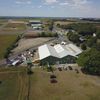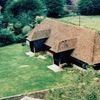
We are delighted to announce that our major refurbishment works are now complete and we are re-open. Come down an see the new exhibits and planes we have been working on and grab a cup of tea and a slice of cake in the new Naafi Cafe whilst you are here. Manston started its Aviation days as a Royal Naval Station in 1916, with a base at Westgate Bay for seaplanes.
The early airfield was on the area now occupied by the passenger terminal. By 1917 Manston airfield had grown to include four underground hangars, its own railway line to Birchington, a power station to generate electricity, barracks for 3,000 men and even an indoor swimming pool. After WW1, training of airmen in airframe maintenance and engine repairs was taught in the School of Technical Training.
The early airfield was on the area now occupied by the passenger terminal. By 1917 Manston airfield had grown to include four underground hangars, its own railway line to Birchington, a power station to generate electricity, barracks for 3,000 men and even an indoor swimming pool. After WW1, training of airmen in airframe maintenance and engine repairs was taught in the School of Technical Training.
Services
About Us
Report
Housed in a large wooden hut that had been used by the Intelligence Section during World War 2, the museum has had a couple of moves to other buildings before settling in its present location, the former Mechanical Transport Section hangars, in the mid 1990's.
Starting with a small but dedicated band of enthusiasts drawn from RAF Manston and also local aviation-minded civilians, the museum has developed and expanded at a steady pace until we now have approximately 100 members and some impressive exhibits.
Starting with a small but dedicated band of enthusiasts drawn from RAF Manston and also local aviation-minded civilians, the museum has developed and expanded at a steady pace until we now have approximately 100 members and some impressive exhibits.
The Early Years
Report
At the outset of the Great War, the Isle of Thanet was equipped with a small and precarious landing strip for aircraft at St Mildreds Bay, Westgate, on top of the chalk cliffs, at the foot of which was a promenade which had been used for seaplane operations.
The landing grounds atop the cliff soon became the scene of several accidents, with at least one plane seen to fail to stop before the end of the cliffs and tumble into the sea, which for the fortunate pilot had been on its inward tide.In the winter of 1915-1916 these early aircraft first began to use the open farmlands at Manston as a site for emergency landings.
The landing grounds atop the cliff soon became the scene of several accidents, with at least one plane seen to fail to stop before the end of the cliffs and tumble into the sea, which for the fortunate pilot had been on its inward tide.In the winter of 1915-1916 these early aircraft first began to use the open farmlands at Manston as a site for emergency landings.
Reviews

Be the first to review R A F Manston History Museum.
Write a Review